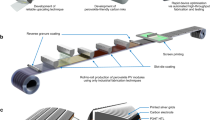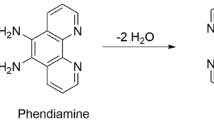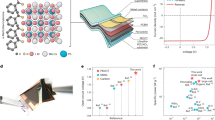Abstract
Building-integrated photovoltaics is gaining consensus as a renewable energy technology for producing electricity at the point of use. Luminescent solar concentrators (LSCs) could extend architectural integration to the urban environment by realizing electrode-less photovoltaic windows. Crucial for large-area LSCs is the suppression of reabsorption losses, which requires emitters with negligible overlap between their absorption and emission spectra. Here, we demonstrate the use of indirect-bandgap semiconductor nanostructures such as highly emissive silicon quantum dots. Silicon is non-toxic, low-cost and ultra-earth-abundant, which avoids the limitations to the industrial scaling of quantum dots composed of low-abundance elements. Suppressed reabsorption and scattering losses lead to nearly ideal LSCs with an optical efficiency of η = 2.85%, matching state-of-the-art semi-transparent LSCs. Monte Carlo simulations indicate that optimized silicon quantum dot LSCs have a clear path to η > 5% for 1 m2 devices. We are finally able to realize flexible LSCs with performances comparable to those of flat concentrators, which opens the way to a new design freedom for building-integrated photovoltaics elements.
This is a preview of subscription content, access via your institution
Access options
Access Nature and 54 other Nature Portfolio journals
Get Nature+, our best-value online-access subscription
$29.99 / 30 days
cancel any time
Subscribe to this journal
Receive 12 print issues and online access
$209.00 per year
only $17.42 per issue
Buy this article
- Purchase on Springer Link
- Instant access to full article PDF
Prices may be subject to local taxes which are calculated during checkout





Similar content being viewed by others
References
Fraunhofer Institute for Solar Energy Systems (ISE). Current and Future Cost of Photovoltaics. Long-Term Scenarios for Market Development, System Prices and LCOE of Utility-Scale PV Systems. Report No. 059/01-S-2015/EN (2015).
The European Parliament and the Council of the European Union. Directive 2010/31/EU of the European Parliament and the Council on the energy performance of buildings (recast). Official Journal of the European Union 23, http://data.europa.eu/eli/dir/2010/31/oj (2010)
Weber, W. H. & Lambe, J. Luminescent greenhouse collector for solar radiation. Appl. Opt. 15, 2299–2300 (1976).
Goetzberger, A. & Greube, W. Solar energy conversion with fluorescent collectors. Appl. Phys. 14, 123–139 (1977).
Debije, M. G. Solar energy collectors with tunable transmission. Adv. Funct. Mater. 20, 1498–1502 (2010).
Debije, M. G. & Verbunt, P. P. C. Solar concentrators: thirty years of luminescent solar concentrator research: solar energy for the built environment. Adv. Energ. Mater. 2, 12–35 (2012).
Meinardi, F. et al. Large-area luminescent solar concentrators based on Stokes-shift-engineered nanocrystals in a mass-polymerized PMMA matrix. Nat. Photon. 8, 392–399 (2014).
Meinardi, F. et al. Highly efficient large-area colourless luminescent solar concentrators using heavy-metal-free colloidal quantum dots. Nat. Nanotech. 10, 878–885 (2015).
van Sark, W. G. J. H. M. Luminescent solar concentrators—a low cost photovoltaics alternative. Renew. Energy 49, 207–210 (2013).
Desmet, L., Ras, A. J. M., de Boer, D. K. G. & Debije, M. G. Monocrystalline silicon photovoltaic luminescent solar concentrator with 4.2% power conversion efficiency. Opt. Lett. 37, 3087–3089 (2012).
Slooff, L. H. et al. A luminescent solar concentrator with 7.1% power conversion efficiency. Phys. Status Solidi Rapid Res. Lett. 2, 257–259 (2008).
Slooff, L. H. et al. Long-term optical stability of fluorescent solar concentrator plates. Phys. Status Solidi A 211, 1150–1154 (2014).
Krumer, Z. et al. Tackling self-absorption in luminescent solar concentrators with type-II colloidal quantum dots. Sol. Energ. Mater. Sol. Cell. 111, 57–65 (2013).
Pietryga, J. M. et al. Spectroscopic and device aspects of nanocrystal quantum dots. Chem. Rev. 116, 10513–10622 (2016).
Giebink, N. C., Wiederrecht, G. P. & Wasielewski, M. R. Resonance-shifting to circumvent reabsorption loss in luminescent solar concentrators. Nat. Photon. 5, 694–701 (2011).
Bomm, J. et al. Fabrication and spectroscopic studies on highly luminescent CdSe/CdS nanorod polymer composites. Beilstein J. Nanotech. 1, 94–100 (2010).
Bradshaw, L. R., Knowles, K. E., McDowall, S. & Gamelin, D. R. Nanocrystals for luminescent solar concentrators. Nano Lett. 15, 1315–1323 (2015).
Bronstein, N. D. et al. Luminescent solar concentration with semiconductor nanorods and transfer-printed micro-silicon solar cells. ACS Nano 8, 44–53 (2013).
Coropceanu, I. & Bawendi, M. G. Core/shell quantum dot based luminescent solar concentrators with reduced reabsorption and enhanced efficiency. Nano Lett. 14, 4097–4101 (2014).
Zhou, Y. et al. Near infrared, highly efficient luminescent solar concentrators. Adv. Energ. Mater. 6, 1501913 (2016).
Li, H., Wu, K., Lim, J., Song, H.-J. & Klimov, V. I. Doctor-blade deposition of quantum dots onto standard window glass for low-loss large-area luminescent solar concentrators. Nat. Energy 1, 16157 (2016).
Erickson, C. S. et al. Zero-reabsorption doped-nanocrystal luminescent solar concentrators. ACS Nano 8, 3461–3467 (2014).
Hu, X. et al. Ray-trace simulation of CuInS(Se)2 quantum dot based luminescent solar concentrators. Opt. Express 23, A858–A867 (2015).
Knowles, K. E., Kilburn, T. B., Alzate, D. G., McDowall, S. & Gamelin, D. R. Bright CuInS2/CdS nanocrystal phosphors for high-gain full-spectrum luminescent solar concentrators. Chem. Commun. 51, 9129–9132 (2015).
Holmes, J. D. et al. Highly luminescent silicon nanocrystals with discrete optical transitions. J. Am. Chem. Soc. 123, 3743–3748 (2001).
Hybertsen, M. S. Absorption and emission of light in nanoscale silicon structures. Phys. Rev. Lett. 72, 1514–1517 (1994).
Lee, B. G. et al. Quasi-direct optical transitions in silicon nanocrystals with intensity exceeding the bulk. Nano Lett. 16, 1583–1589 (2016).
Hessel, C. M. et al. Synthesis of ligand-stabilized silicon nanocrystals with size-dependent photoluminescence spanning visible to near-infrared wavelengths. Chem. Mater. 24, 393–401 (2012).
Mangolini, L. & Kortshagen, U. Plasma-assisted synthesis of silicon nanocrystal inks. Adv. Mater. 19, 2513–2519 (2007).
Mangolini, L., Thimsen, E. & Kortshagen, U. High-yield plasma synthesis of luminescent silicon nanocrystals. Nano Lett. 5, 655–659 (2005).
Meier, C., Gondorf, A., Lüttjohann, S., Lorke, A. & Wiggers, H. Silicon nanoparticles: absorption, emission, and the nature of the electronic bandgap. J. Appl. Phys. 101, 103112 (2007).
Sychugov, I., Pevere, F., Luo, J.-W., Zunger, A. & Linnros, J. Single-dot absorption spectroscopy and theory of silicon nanocrystals. Phys. Rev. B 93, 161413 (2016).
Jurbergs, D., Rogojina, E., Mangolini, L. & Kortshagen, U. Silicon nanocrystals with ensemble quantum yields exceeding 60%. Appl. Phys. Lett. 88, 233116 (2006).
Anthony, R. & Kortshagen, U. Photoluminescence quantum yields of amorphous and crystalline silicon nanoparticles. Phys. Rev. B 80, 115407 (2009).
Anthony, R. J., Rowe, D. J., Stein, M., Yang, J. & Kortshagen, U. Routes to achieving high quantum yield luminescence from gas-phase-produced silicon nanocrystals. Adv. Funct. Mater. 21, 4042–4046 (2011).
Erogbogbo, F. et al. In vivo targeted cancer imaging, sentinel lymph node mapping and multi-channel imaging with biocompatible silicon nanocrystals. ACS Nano 5, 413–423 (2011).
Cheng, K.-Y., Anthony, R., Kortshagen, U. R. & Holmes, R. J. High-efficiency silicon nanocrystal light-emitting devices. Nano Lett. 11, 1952–1956 (2011).
Ng, W. L. et al. An efficient room-temperature silicon-based light-emitting diode. Nature 410, 192–194 (2001).
Hannah, D. C. et al. On the origin of photoluminescence in silicon nanocrystals: pressure-dependent structural and optical studies. Nano Lett. 12, 4200–4205 (2012).
Delerue, C., Allan, G. & Lannoo, M. Electron–phonon coupling and optical transitions for indirect-gap semiconductor nanocrystals. Phys. Rev. B 64, 193402 (2001).
Tolcin, A. C. Mineral Commodity Summaries 2015 (U.S. Geological Survey, 2015).
Moss, R. L., Tzimas, E., Kara, H., Willis, P. & Kooroshy, J. Critical Metals in Strategic Energy Technologies, Assessing Rare Metals as Supply-Chain Bottlenecks in Low-Carbon Energy Technologies (Joint Research Centre, European Commission, 2011).
Wu, J. J. & Kortshagen, U. R. Photostability of thermally-hydrosilylated silicon quantum dots. RSC Adv. 5, 103822–103828 (2015).
Wilson, W. L., Szajowski, P. F. & Brus, L. E. Quantum confinement in size-selected, surface-oxidized silicon nanocrystals. Science 262, 1242–1244 (1993).
Goldschmidt, J. C. et al. Increasing the efficiency of fluorescent concentrator systems. Sol. Energ. Mater. Sol. Cell. 93, 176–182 (2009).
Debije, M. G. et al. Effect on the output of a luminescent solar concentrator on application of organic wavelength-selective mirrors. Appl. Opt. 49, 745–751 (2010).
Sangghaleh, F., Sychugov, I., Yang, Z., Veinot, J. G. C. & Linnros, J. Near-unity internal quantum efficiency of luminescent silicon nanocrystals with ligand passivation. ACS Nano 9, 7097–7104 (2015).
Vishwanathan, B. et al. A comparison of performance of flat and bent photovoltaic luminescent solar concentrators. Sol. Energy 112, 120–127 (2015).
Tummeltshammer, C., Taylor, A., Kenyon, A. J. & Papakonstantinou, I. Flexible and fluorophore-doped luminescent solar concentrators based on polydimethylsiloxane. Opt. Lett. 41, 713–716 (2016).
Acknowledgements
S.B. acknowledges the European Community's Seventh Framework Programme (FP7/2007-2013) for financial support (EDONHIST) under grant agreement no. 324603. U.K. and S.E. were supported by the Center for Advanced Solar Photophysics (CASP), an Energy Frontier Research Center funded by the Office of Basic Energy Sciences, Office of Science, US Department of Energy. S.E. also acknowledges support through the NSF Graduate Research Fellowship Program under grant NSF GRFP 00039202. The authors thank M. Acciarri and the staff of the MIB-SOLAR Laboratory for technical assistance with quantitative studies of solar concentration.
Author information
Authors and Affiliations
Contributions
The experimental designs were the result of interactions and discussions between S.B. and U.K. S.E. synthesized the quantum dots. L.D. and F.C. fabricated the quantum dot–polymer nanocomposites with the assistance of S.B., R.S. and M.M. S.B. and F.M. planned the experiments. L.D., F.M., F.B. and S.B. performed the spectroscopic experiments and characterized the LSCs. F.M. performed the Monte Carlo simulations. S.B. wrote the paper, in consultation with all authors.
Corresponding authors
Ethics declarations
Competing interests
The authors declare no competing financial interests.
Supplementary information
Supplementary information
Supplementary information (PDF 819 kb)
Rights and permissions
About this article
Cite this article
Meinardi, F., Ehrenberg, S., Dhamo, L. et al. Highly efficient luminescent solar concentrators based on earth-abundant indirect-bandgap silicon quantum dots. Nature Photon 11, 177–185 (2017). https://doi.org/10.1038/nphoton.2017.5
Received:
Accepted:
Published:
Issue Date:
DOI: https://doi.org/10.1038/nphoton.2017.5
This article is cited by
-
A comprehensive dataset of photonic features on spectral converters for energy harvesting
Scientific Data (2024)
-
Luminescent solar concentrator efficiency enhanced via nearly lossless propagation pathways
Nature Photonics (2024)
-
Luminescent concentrator design for displays with high ambient contrast and efficiency
Nature Photonics (2023)
-
Mid-infrared plasmonic silicon quantum dot/HgCdTe photodetector with ultrahigh specific detectivity
Science China Information Sciences (2023)
-
Single-step acid-catalyzed synthesis of luminescent colloidal organosilica nanobeads
Nano Convergence (2022)



